By Roy Grace
For some reason I've always adored the mule deer. Whether I'm chasing them in their high altitude-summer range of the Rocky Mountains, or the cactus laden landscape of the Sonoran Desert, they have always been my favorite to pursue with a bow and arrow. Oh, I've hunted other North American big game animals like the majestic wapiti, and they too can be exciting to hunt, especially when the mating ritual takes place and bugles fill the early morning mountain air; but for some reason my thoughts usually drift back to the mule deer. Maybe it's their solitary and often nomadic nature, or their keen eyesight and a sense of hearing that can detect the slightest decibel that draws me to them. Honestly, at least for me, it's simply an animal that represents something lost in today's modern society; a truly wild and free ranging animal that inhabits some of the harshest and roughest country the West has to offer; and to arrow a good one, is one of the most difficult, yet rewarding, challenges a bowhunter can achieve.
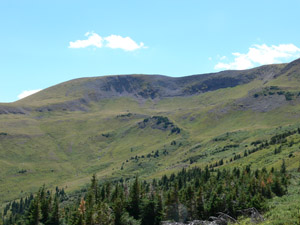 Typical above timberline country with sporadic alpine willow patches |
At first glance, the high-country will resemble parts of Alaska with alpine-like tundra vegetation that grows no higher than your ankle. An occasional grove of Krummholz may be present, signifying an ecological struggle for dominance in an elevation suited for no tree life. But what also grows in this country near 12,000' is alpine willow; a main food source for mule deer during this late summer timeframe. I can't count how many times I've glassed mule deer, above timberline, feeding on willow patches in some of the most beautiful yet roughest country God has ever created. There's an old saying that still holds true, "If you want to kill a big mule deer, go sheep hunting."
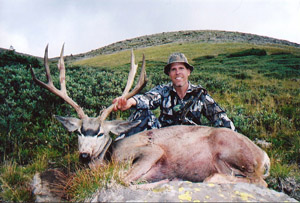 Buck arrowed at 12,500'. Note the alpine willow in the background |
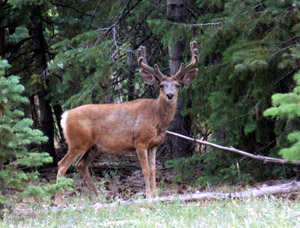 Buck in the upper level of the transition range in the Kaibab of Northern Arizona |
Bowhunting the lower level of the transition range (sagebrush/bitterbrush country) is much like above timberline ranges in that glassing becomes an important factor in successfully spotting mule deer. Perched on high points or ridges, I generally scour the country with quality optics looking for mule deer or often a portion of their velvet covered antlers sticking up from the sagebrush. Generally, in good mule deer range, I find them in bachelor herds ranging from 4-12 bucks during the early bowhunt. While making them much easier to spot in groups, it also creates a problem when I try and sneak in on a particular buck without being detected.
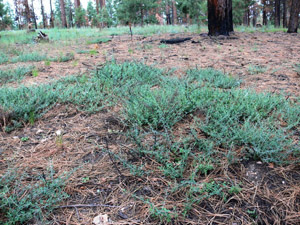 Photo of buck brush on the Kaibab (transition range) |
Mule deer feed on a variety of food sources in the transition range. Bitterbrush (Cliffrose) and Mountain Mahogany are popular food sources at the lower levels of this range as well as other forbs and grasses. As you gain elevation, aspen leaves, buck brush, and lupine are some of their favorite browse. In all the years I've bowhunted the Kaibab Plateau; I have always found mule deer browsing on the abundant lupine patches spread throughout the range.
Water is the key ingredient to finding mule deer in the transition range. Much of the lower elevation of this range is considered desert based on the amount of annual precipitation, so water is a necessity for mule deer survival. I generally try and locate seeps, springs or guzzlers, coupled with their food source, to locate mule deer. Usually, if water is available and food and cover is nearby, I will eventually find mule deer. Now, not all of these areas will produce mule deer. When I bowhunted the Arizona Strip, I was amazed at the amount of acres of prime mule deer country that held all three necessities(food, water, cover); yet I saw few, if any, mule deer in these areas. However, I soon learned that the Strip is close to 5300 square miles and only 2000 mule deer inhabit it. Finding the productive areas that mule deer inhabit on the Strip was crucial to a successful hunt.
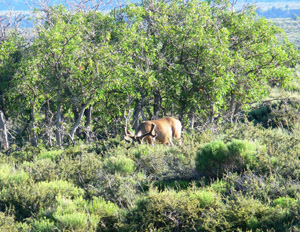 Buck feeding on bitter brush & sage in the lower levels of the transition range |
Bowhunting the transition range can be very rewarding, as it generally holds larger numbers of mule deer (in good ranges) and provides good access for most bowhunters without a lot of physical exertion.
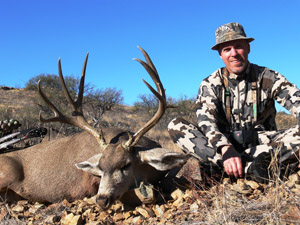 Buck arrowed in Sonoran Desert range |
Bowhunting any low desert unit creates a unique experience with not only flatter terrain features but also a variety of plant-life that survives in this arid region. Almost everything that grows in this type of country will either stick, sting, or bite you. However, what also grows in this type of range is mesquite. Mesquite trees produce a bean pod that belongs to the legumes family. It is extremely high in protein and a common food source for desert mule deer. Additionally, a variety of cacti and browse is also found in this region providing enough quality food sources for the mule deer to survive.
Similarly to the transition range, water is a key ingredient to locating mule deer in this desolate country. Unlike most traditional mule deer ranges, July & August are the wet seasons for the Sonoran Desert when the Monsoon season arrives. It is not uncommon for this region to receive 90% of their annual rainfall for the year during this late summer season. Thunderstorms that produce several of inches of rain in a day are often needed to fill crucial water holes and springs for the wildlife that depend on it for survival.
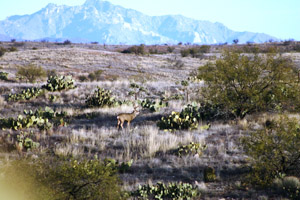 Buck in typical Sonoran Desert range |
Since mule deer of this region are widely dispersed and their respective food sources are high in protein and minerals, they have the potential to grow very impressive antlers. Furthermore, since this range is not as popular as other ranges I've discussed, mule deer have the potential to reach maturity. I can't count how many giant desert mule deer I've seen over the years in this range that would rival those from some of the most famous mule deer ranges in the West. While not easily bowhunted, the Sonoran Desert range is worth a closer look for those who wish to extend their season into the New Year.
As you can see, I've found mule deer in a variety of ecological and geographical regions. From the above timberline ranges with extreme elevations, the lower transition ranges, all the way down to the low elevation range of the Sonoran Desert; mule deer can be found and bowhunted. It's what makes them so special and challenging to bowhunt. In the next series of articles, I will dedicate specific tactics and strategies I use to bowhunt each of the three different ranges described today. Each of them has their own unique environment that creates different challenges for today's bowhunters. It is this challenge and their nomadic nature that has driven me to pursue them annually for well over 30 years…….and hopefully for 30 more!
Click-a-Pic ... Details & Bigger Photos
Click-a-Pic ... Details & Bigger Photos
Videos | Hunts & Tags | About Mule Deer | About Elk
Classified Ads | Photo Tours | About this Site | Advertising |
Older Content | Email Us | Privacy Policy
